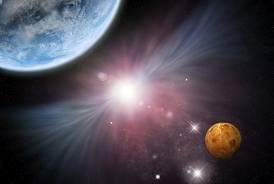

What if I told you that the planets didn’t all form at the same time? Crazy, I know. Current solar system formation models state that the cloud of gas, which condensed to form our system, did so in an elliptical disk and everything – Sun, planets, and asteroids – formed at once. A new model developed by Dr. Tagir Abdylmyanov suggests the current model might be wrong.

Instead, Dr. Abdylmyanov believes a series of shockwaves from the young and turbulent Sun would have resulted in the formation of the planets, of course, staggering their formation process. This means all of the planets in the solar system are vastly different ages, millions of years apart from one another. One of the most exciting attributes of this theory is it will give scientists the ability to estimate where planets form in other solar systems.
So, how does this work? The good doctor modeled the movements of gas inside the nebula that gave rise to our solar system. His work suggests shockwaves rippled through the solar system from our evolving Sun. These shockwaves resulted in rings of material, which formed protoplanetary rights and eventually, over the course of millions of years, formed the planets.

First on the formation agenda would have been the protoplanetary rings that formed the dwarf planet Pluto, along with Neptune and Uranus. Next up, the material for Saturn, Jupiter, and the asteroid belt would have rippled through the system. After which, as the Sun was calming down and stabilizing, it would have created the rings that lead to the formation of Mars, Earth, Venus, and Mercury. Of course, this also means that the inner planets are the youngest in the solar system.
I do hesitate when writing about this new theory on the formation of the solar system because this experiment has not been published in a peer-reviewed journal. Instead, Abdylmyanov presented his new theory in Madrid, Spain at the European Planetary Science Congress. (Note: Clicking this link will take you to a PDF file from phys.org)
However exciting it may be, until this model in tested by the scientific community, it remains a cool idea thought of by a clever scientist while trying to further develop our understanding of the solar system’s early history.